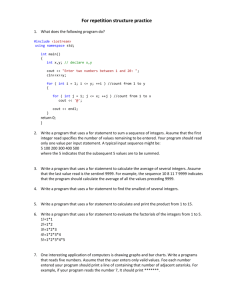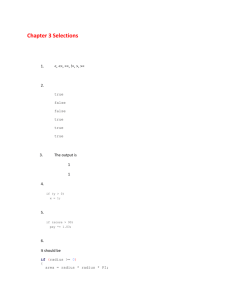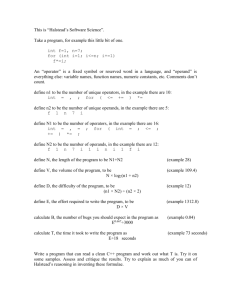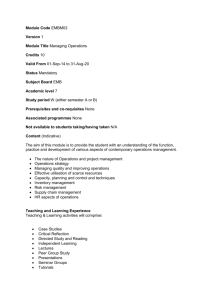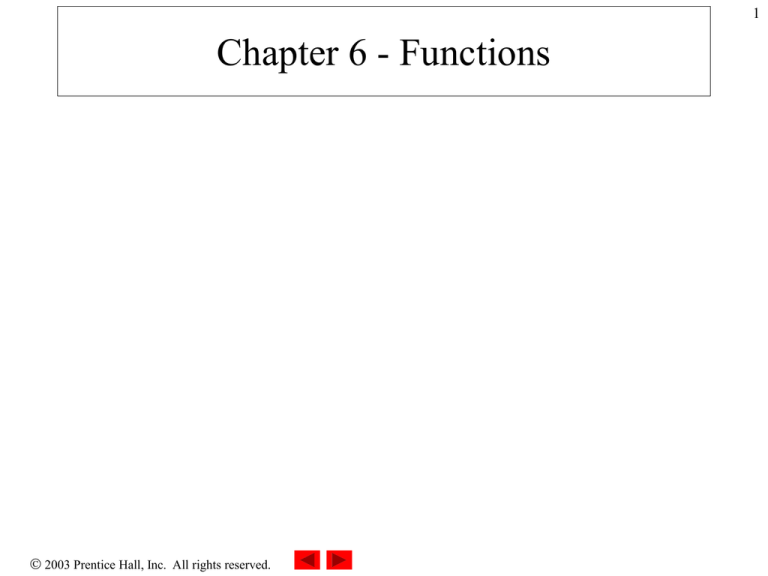
1
Chapter 6 - Functions
2003 Prentice Hall, Inc. All rights reserved.
2
3.1
Introduction
• Divide and conquer
– Construct a program from smaller pieces or components
– Each piece more manageable than the original program
2003 Prentice Hall, Inc. All rights reserved.
3
3.2
Program Components in C++
• Modules: functions and classes
• Programs use new and “prepackaged” modules
– New: programmer-defined functions, classes
– Prepackaged: from the standard library
• Functions invoked by function call
– Function name and information (arguments) it needs
• Function definitions
– Only written once
– Hidden from other functions
2003 Prentice Hall, Inc. All rights reserved.
4
3.2
Program Components in C++
• Boss to worker analogy
– A boss (the calling function or caller) asks a worker (the
called function) to perform a task and return (i.e., report
back) the results when the task is done.
2003 Prentice Hall, Inc. All rights reserved.
5
3.3
Math Library Functions
• Perform common mathematical calculations
– Include the header file <cmath>
• Functions called by writing
– functionName (argument);
or
– functionName(argument1, argument2, …);
• Example
cout << sqrt( 900.0 );
– sqrt (square root) function The preceding statement would
print 30
– All functions in math library return a double
2003 Prentice Hall, Inc. All rights reserved.
6
3.3
Math Library Functions
• Function arguments can be
– Constants
• sqrt( 4 );
– Variables
• sqrt( x );
– Expressions
• sqrt( sqrt( x ) ) ;
• sqrt( 3 - 6x );
2003 Prentice Hall, Inc. All rights reserved.
7
M e tho d
ceil( x )
De sc rip tio n
Exa m p le
rounds x to the smallest integer ceil( 9.2 ) is 10.0
not less than x
ceil( -9.8 ) is -9.0
cos( x )
trigonometric cosine of x
cos( 0.0 ) is 1.0
(x in radians)
exp( x )
exponential function ex
exp( 1.0 ) is 2.71828
exp( 2.0 ) is 7.38906
fabs( x )
absolute value of x
fabs( 5.1 ) is 5.1
fabs( 0.0 ) is 0.0
fabs( -8.76 ) is 8.76
floor( x )
rounds x to the largest integer
floor( 9.2 ) is 9.0
not greater than x
floor( -9.8 ) is -10.0
fmod( x, y )
remainder of x/y as a floating- fmod( 13.657, 2.333 ) is 1.992
point number
log( x )
natural logarithm of x (base e) log( 2.718282 ) is 1.0
log( 7.389056 ) is 2.0
log10( x )
logarithm of x (base 10)
log10( 10.0 ) is 1.0
log10( 100.0 ) is 2.0
pow( x, y )
x raised to power y (xy)
pow( 2, 7 ) is 128
pow( 9, .5 ) is 3
sin( x )
trigonometric sine of x
sin( 0.0 ) is 0
(x in radians)
sqrt( x )
square root of x
sqrt( 900.0 ) is 30.0
sqrt( 9.0 ) is 3.0
tan( x )
trigonometric tangent of x
tan( 0.0 ) is 0
(x in radians)
Fig . 3.2 M a th lib ra ry func tio ns.
2003 Prentice Hall, Inc. All rights reserved.
8
3.4
Functions
• Functions
– Modularize a program
– Software reusability
• Call function multiple times
• Local variables
– Known only in the function in which they are defined
– All variables declared in function definitions are local
variables
• Parameters
– Local variables passed to function when called
– Provide outside information
2003 Prentice Hall, Inc. All rights reserved.
9
3.5
Function Definitions
• Function prototype
– Tells compiler argument type and return type of function
– int square( int );
• Function takes an int and returns an int
– Explained in more detail later
• Calling/invoking a function
– square(x);
– Parentheses an operator used to call function
• Pass argument x
• Function gets its own copy of arguments
– After finished, passes back result
2003 Prentice Hall, Inc. All rights reserved.
10
3.5
Function Definitions
• Format for function definition
return-value-type function-name( parameter-list )
{
declarations and statements
}
– Parameter list
• Comma separated list of arguments
– Data type needed for each argument
• If no arguments, use void or leave blank
– Return-value-type
• Data type of result returned (use void if nothing returned)
2003 Prentice Hall, Inc. All rights reserved.
11
3.5
Function Definitions
• Example function
int square( int y )
{
return y * y;
}
• return keyword
– Returns data, and control goes to function’s caller
• If no data to return, use return;
– Function ends when reaches right brace
• Control goes to caller
• Functions cannot be defined inside other functions
• Next: program examples
2003 Prentice Hall, Inc. All rights reserved.
1
2
3
4
5
6
7
8
9
10
11
12
13
14
15
16
17
18
19
20
21
22
// Fig. 3.3: fig03_03.cpp
// Creating and using a programmer-defined function.
#include <iostream>
using std::cout;
using std::endl;
int square( int );
//
Function prototype: specifies
data types of arguments and
return values. square
expects and int, and returns
function prototype
an int.
12
Outline
fig03_03.cpp
(1 of 2)
int main()
{
Parentheses () cause
// loop 10 times and calculate and output
function to be called. When
// square of x each time
done, it returns the result.
for ( int x = 1; x <= 10; x++ )
cout << square( x ) << " "; // function call
cout << endl;
return 0;
// indicates successful termination
} // end main
2003 Prentice Hall, Inc.
All rights reserved.
23
24
25
26
27
28
1
// square function definition returns square of an integer
int square( int y ) // y is a copy of argument to function
{
return y * y;
// returns square of y as an int
} // end function square
4
9
16
25
36
49
64
81
100
Definition of square. y is a
copy of the argument passed.
Returns y * y, or y squared.
13
Outline
fig03_03.cpp
(2 of 2)
fig03_03.cpp
output (1 of 1)
2003 Prentice Hall, Inc.
All rights reserved.
1
2
3
4
5
6
7
8
9
10
11
12
13
14
15
16
17
18
19
20
21
22
23
24
25
// Fig. 3.4: fig03_04.cpp
// Finding the maximum of three floating-point numbers.
#include <iostream>
14
Outline
fig03_04.cpp
(1 of 2)
using std::cout;
using std::cin;
using std::endl;
double maximum( double, double, double ); // function prototype
int main()
{
double number1;
double number2;
double number3;
Function maximum takes 3
arguments (all double) and
returns a double.
cout << "Enter three floating-point numbers: ";
cin >> number1 >> number2 >> number3;
// number1, number2 and number3 are arguments to
// the maximum function call
cout << "Maximum is: "
<< maximum( number1, number2, number3 ) << endl;
return 0;
// indicates successful termination
2003 Prentice Hall, Inc.
All rights reserved.
26
27
28
29
30
31
32
33
34
35
36
37
38
39
40
41
42
43
15
Outline
} // end main
Comma separated list for
multiple parameters.
// function maximum definition;
// x, y and z are parameters
double maximum( double x, double y, double z )
{
double max = x;
// assume x is largest
if ( y > max )
max = y;
// if y is larger,
// assign y to max
if ( z > max )
max = z;
// if z is larger,
// assign z to max
return max;
// max is largest value
fig03_04.cpp
(2 of 2)
fig03_04.cpp
output (1 of 1)
} // end function maximum
Enter three floating-point numbers: 99.32 37.3 27.1928
Maximum is: 99.32
Enter three floating-point numbers: 1.1 3.333 2.22
Maximum is: 3.333
Enter three floating-point numbers: 27.9 14.31 88.99
Maximum is: 88.99
2003 Prentice Hall, Inc.
All rights reserved.
16
3.6
Function Prototypes
• Function prototype contains
– Function name
– Parameters (number and data type)
– Return type (void if returns nothing)
– Only needed if function definition after function call
• Prototype must match function definition
– Function prototype
double maximum( double, double, double );
– Definition
double maximum( double x, double y, double z )
{
…
}
2003 Prentice Hall, Inc. All rights reserved.
17
3.6
Function Prototypes
• Function signature
– Part of prototype with name and parameters
• double maximum( double, double, double );
• Argument Coercion
Function signature
– Force arguments to be of proper type
• Converting int (4) to double (4.0)
cout << sqrt(4)
– Conversion rules
• Arguments usually converted automatically
• Changing from double to int can truncate data
– 3.4 to 3
– Mixed type goes to highest type (promotion)
• Int * double
2003 Prentice Hall, Inc. All rights reserved.
18
3.6
Function Prototypes
Da ta typ es
long double
double
float
unsigned long int
(synonymous with unsigned long)
long int
(synonymous with long)
unsigned int
(synonymous with unsigned)
int
unsigned short int
(synonymous with unsigned short)
short int
(synonymous with short)
unsigned char
char
bool
(false becomes 0, true becomes 1)
Fig . 3.5 Pro m o tio n hiera rc hy fo r b uilt-in d a ta typ es.
2003 Prentice Hall, Inc. All rights reserved.
19
3.7
Header Files
• Header files contain
– Function prototypes
– Definitions of data types and constants
• Header files ending with .h
– Programmer-defined header files
#include “myheader.h”
• Library header files
#include <cmath>
2003 Prentice Hall, Inc. All rights reserved.
20
3.8
Random Number Generation
• rand function (<cstdlib>)
– i = rand();
– Generates unsigned integer between 0 and RAND_MAX
(usually 32767)
• Scaling and shifting
– Modulus (remainder) operator: %
• 10 % 3 is 1
• x % y is between 0 and y – 1
– Example
i = rand() % 6 + 1;
• “Rand() % 6” generates a number between 0 and 5 (scaling)
• “+ 1” makes the range 1 to 6 (shift)
– Next: program to roll dice
2003 Prentice Hall, Inc. All rights reserved.
1
2
3
4
5
6
7
8
9
10
11
12
13
14
15
16
17
18
19
20
21
22
23
24
25
26
// Fig. 3.7: fig03_07.cpp
// Shifted, scaled integers produced by 1 + rand() % 6.
#include <iostream>
21
Outline
fig03_07.cpp
(1 of 2)
using std::cout;
using std::endl;
#include <iomanip>
using std::setw;
#include <cstdlib>
// contains function prototype for rand
int main()
{
// loop 20 times
Output
for ( int counter = 1; counter <= 20; counter++ ) {
// pick random number from 1 to 6 and output
cout << setw( 10 ) << ( 1 + rand() % 6 );
of rand() scaled and
shifted to be a number
it between 1 and 6.
// if counter divisible by 5, begin new line of output
if ( counter % 5 == 0 )
cout << endl;
} // end for structure
2003 Prentice Hall, Inc.
All rights reserved.
27
28
29
30
22
return 0;
// indicates successful termination
} // end main
6
5
6
6
6
1
6
2
5
1
2
3
5
5
4
4
6
3
2
1
Outline
fig03_07.cpp
(2 of 2)
fig03_07.cpp
output (1 of 1)
2003 Prentice Hall, Inc.
All rights reserved.
23
3.8
Random Number Generation
• Next
– Program to show distribution of rand()
– Simulate 6000 rolls of a die
– Print number of 1’s, 2’s, 3’s, etc. rolled
– Should be roughly 1000 of each
2003 Prentice Hall, Inc. All rights reserved.
1
2
3
4
5
6
7
8
9
10
11
12
13
14
15
16
17
18
19
20
21
22
23
// Fig. 3.8: fig03_08.cpp
// Roll a six-sided die 6000 times.
#include <iostream>
24
Outline
fig03_08.cpp
(1 of 3)
using std::cout;
using std::endl;
#include <iomanip>
using std::setw;
#include <cstdlib>
// contains function prototype for rand
int main()
{
int frequency1 = 0;
int frequency2 = 0;
int frequency3 = 0;
int frequency4 = 0;
int frequency5 = 0;
int frequency6 = 0;
int face; // represents one roll of the die
2003 Prentice Hall, Inc.
All rights reserved.
24
25
26
27
28
29
30
31
32
33
34
35
36
37
38
39
40
41
42
43
44
45
46
47
48
49
// loop 6000 times and summarize results
for ( int roll = 1; roll <= 6000; roll++ ) {
face = 1 + rand() % 6; // random number from 1 to 6
// determine face value and increment appropriate counter
switch ( face ) {
25
Outline
fig03_08.cpp
(2 of 3)
case 1:
// rolled 1
++frequency1;
break;
case 2:
// rolled 2
++frequency2;
break;
case 3:
// rolled 3
++frequency3;
break;
case 4:
// rolled 4
++frequency4;
break;
case 5:
// rolled 5
++frequency5;
break;
2003 Prentice Hall, Inc.
All rights reserved.
50
51
52
53
54
55
56
57
58
59
60
61
62
63
64
65
66
67
68
69
70
71
72
73
26
case 6:
// rolled 6
++frequency6;
break;
default:
// invalid value
cout << "Program should never get here!";
} // end switch
} // end for
fig03_08.cpp
(3 of 3)
Default case included even
though it should never be
reached. This is a matter of
good
coding style
tabular
format
// display results in
cout << "Face" << setw( 13 )
<< "\n
1" << setw( 13
<< "\n
2" << setw( 13
<< "\n
3" << setw( 13
<< "\n
4" << setw( 13
<< "\n
5" << setw( 13
<< "\n
6" << setw( 13
return 0;
Outline
<< "Frequency"
) << frequency1
) << frequency2
) << frequency3
) << frequency4
) << frequency5
) << frequency6 << endl;
// indicates successful termination
} // end main
2003 Prentice Hall, Inc.
All rights reserved.
Face
1
2
3
4
5
6
Frequency
1003
1017
983
994
1004
999
27
Outline
fig03_08.cpp
output (1 of 1)
2003 Prentice Hall, Inc.
All rights reserved.
28
3.8
Random Number Generation
• Calling rand() repeatedly
– Gives the same sequence of numbers
• Pseudorandom numbers
– Preset sequence of "random" numbers
– Same sequence generated whenever program run
• To get different random sequences
– Provide a seed value
• Like a random starting point in the sequence
• The same seed will give the same sequence
– srand(seed);
• <cstdlib>
• Used before rand() to set the seed
2003 Prentice Hall, Inc. All rights reserved.
1
2
3
4
5
6
7
8
9
10
11
12
13
14
15
16
17
18
19
20
21
22
23
24
// Fig. 3.9: fig03_09.cpp
// Randomizing die-rolling program.
#include <iostream>
29
Outline
fig03_09.cpp
(1 of 2)
using std::cout;
using std::cin;
using std::endl;
#include <iomanip>
using std::setw;
// contains prototypes for functions srand and rand
#include <cstdlib>
// main function begins program execution
int main()
{
unsigned seed;
Setting the seed with
srand().
cout << "Enter seed: ";
cin >> seed;
srand( seed ); // seed random number generator
2003 Prentice Hall, Inc.
All rights reserved.
25
26
27
28
29
30
31
32
33
34
35
36
37
38
39
// loop 10 times
for ( int counter = 1; counter <= 10; counter++ ) {
// pick random number from 1 to 6 and output it
cout << setw( 10 ) << ( 1 + rand() % 6 );
// if counter divisible by 5, begin new line of output
if ( counter % 5 == 0 )
cout << endl;
30
Outline
fig03_09.cpp
(2 of 2)
fig03_09.cpp
output (1 of 1)
} // end for
return 0;
// indicates successful termination
rand() gives the same
sequence if it has the same
initial seed.
} // end main
Enter seed: 67
6
1
1
6
4
1
6
6
2
4
Enter seed: 432
4
3
6
1
3
5
1
4
6
2
Enter seed: 67
6
1
1
6
4
1
6
6
2
4
2003 Prentice Hall, Inc.
All rights reserved.
31
3.8
Random Number Generation
• Can use the current time to set the seed
– No need to explicitly set seed every time
– srand( time( 0 ) );
– time( 0 );
• <ctime>
• Returns current time in seconds
• General shifting and scaling
– Number = shiftingValue + rand() % scalingFactor
– shiftingValue = first number in desired range
– scalingFactor = width of desired range
2003 Prentice Hall, Inc. All rights reserved.
32
3.9
Example: Game of Chance and
Introducing enum
• Enumeration
– Set of integers with identifiers
enum typeName {constant1, constant2…};
– Constants start at 0 (default), incremented by 1
– Constants need unique names
– Cannot assign integer to enumeration variable
• Must use a previously defined enumeration type
• Example
enum Status {CONTINUE, WON, LOST};
Status enumVar;
enumVar = WON; // cannot do enumVar = 1
2003 Prentice Hall, Inc. All rights reserved.
33
3.9
Example: Game of Chance and
Introducing enum
• Enumeration constants can have preset values
enum Months { JAN = 1, FEB, MAR, APR, MAY,
JUN, JUL, AUG, SEP, OCT, NOV, DEC};
– Starts at 1, increments by 1
• Next: craps simulator
–
–
–
–
Roll two dice
7 or 11 on first throw: player wins
2, 3, or 12 on first throw: player loses
4, 5, 6, 8, 9, 10
• Value becomes player's "point"
• Player must roll his point before rolling 7 to win
2003 Prentice Hall, Inc. All rights reserved.
1
2
3
4
5
6
7
8
9
10
11
12
13
14
15
16
17
18
19
20
21
22
23
24
34
// Fig. 3.10: fig03_10.cpp
// Craps.
#include <iostream>
Outline
fig03_10.cpp
(1 of 5)
using std::cout;
using std::endl;
// contains function prototypes for functions srand and rand
#include <cstdlib>
#include <ctime>
// contains
int rollDice( void );
Function to roll 2 dice and
return the
as an time
int.
prototype
forresult
function
// function prototype
Enumeration to keep track of
int main()
the current game.
{
// enumeration constants represent game status
enum Status { CONTINUE, WON, LOST };
int sum;
int myPoint;
Status gameStatus;
// can contain CONTINUE, WON or LOST
2003 Prentice Hall, Inc.
All rights reserved.
25
26
27
28
29
30
31
32
33
34
35
36
37
38
39
40
41
42
43
44
45
// randomize random number generator using current time
srand( time( 0 ) );
sum = rollDice();
statement
// first switch
roll of the
dice
// determine game status and
switch ( sum ) {
determines outcome based on
die
roll.based on sum of dice
point
35
Outline
fig03_10.cpp
(2 of 5)
// win on first roll
case 7:
case 11:
gameStatus = WON;
break;
// lose on first roll
case 2:
case 3:
case 12:
gameStatus = LOST;
break;
2003 Prentice Hall, Inc.
All rights reserved.
46
47
48
49
50
51
52
53
54
55
56
57
58
59
60
61
62
63
64
65
66
67
// remember point
default:
gameStatus = CONTINUE;
myPoint = sum;
cout << "Point is " << myPoint << endl;
break;
// optional
36
Outline
fig03_10.cpp
(3 of 5)
} // end switch
// while game not complete ...
while ( gameStatus == CONTINUE ) {
sum = rollDice();
// roll dice again
// determine game status
if ( sum == myPoint )
gameStatus = WON;
else
if ( sum == 7 )
gameStatus = LOST;
// win by making point
// lose by rolling 7
} // end while
2003 Prentice Hall, Inc.
All rights reserved.
68
69
70
71
72
73
74
75
76
77
78
79
80
81
82
83
84
85
86
87
88
// display won or lost message
if ( gameStatus == WON )
cout << "Player wins" << endl;
else
cout << "Player loses" << endl;
return 0;
37
Outline
fig03_10.cpp
(4 of 5)
// indicates successful termination
} // end main
// roll dice, calculate sum and
int rollDice( void )
{
int die1;
int die2;
int workSum;
die1 = 1 + rand() % 6;
die2 = 1 + rand() % 6;
workSum = die1 + die2;
Function rollDice takes no
arguments, so has void in
the parameter
display
resultslist.
// pick random die1 value
// pick random die2 value
// sum die1 and die2
2003 Prentice Hall, Inc.
All rights reserved.
89
90
91
92
93
94
95
// display results of this roll
cout << "Player rolled " << die1 << " + " << die2
<< " = " << workSum << endl;
return workSum;
// return sum of dice
38
Outline
fig03_10.cpp
(5 of 5)
} // end function rollDice
Player rolled 2 + 5 = 7
Player wins
fig03_10.cpp
output (1 of 2)
Player rolled 6 + 6 = 12
Player loses
Player rolled
Point is 6
Player rolled
Player rolled
Player rolled
Player rolled
Player wins
3 + 3 = 6
5
4
2
1
+
+
+
+
3
5
1
5
=
=
=
=
8
9
3
6
2003 Prentice Hall, Inc.
All rights reserved.
Player rolled
Point is 4
Player rolled
Player rolled
Player rolled
Player rolled
Player rolled
Player rolled
Player rolled
Player rolled
Player loses
1 + 3 = 4
4
2
6
2
2
1
4
4
+
+
+
+
+
+
+
+
6
4
4
3
4
1
4
3
=
=
=
=
=
=
=
=
10
6
10
5
6
2
8
7
39
Outline
fig03_10.cpp
output (2 of 2)
2003 Prentice Hall, Inc.
All rights reserved.

